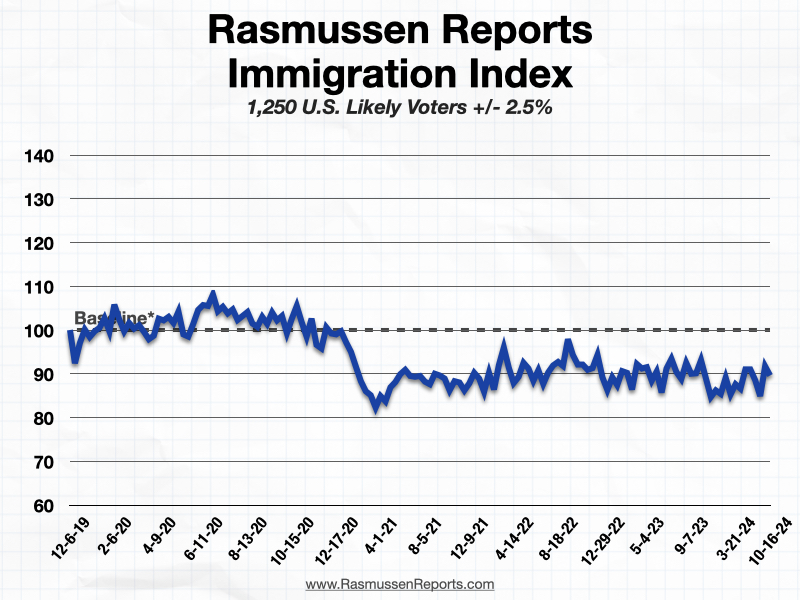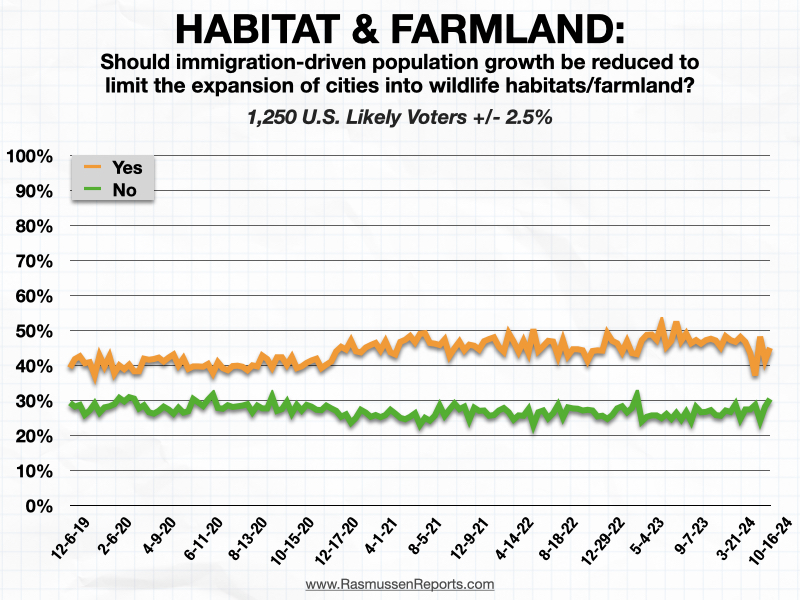Rasmussen Reports Immigration Index - Week Ending September 22, 2022
The Rasmussen Reports Immigration Index for the week of September 11-22, 2022, increased to 97.9, up more than six points from 91.8 three weeks earlier. The Immigration Index has been under the baseline in every survey since Election Day last year, and reached a record low of 82.3 in late March 2021. The index is about five points below where it was in late October 2020, indicating voters are looking for tighter immigration control from President Joe Biden's administration.
The Index is based on a series of questions designed to determine whether voters are moving toward an immigration system that encourages more immigration to the United States or one that reduces the level of immigration here. (To see survey question wording, click here.)
All surveys are compared to a baseline – set the week of December 2-6, 2019 - which has been given an Index of 100. A weekly finding moving up over 100 indicates growing support for a more expansive immigration system. A weekly index number falling below 100 indicates increased support for a more restrictive immigration system.
Crosstabs, topline responses and historical data are also available to the public.
The Immigration Index will be updated every other Tuesday at noon Eastern.
(Want a free daily e-mail update? If it's in the news, it's in our polls). Rasmussen Reports updates are also available on Twitter or Facebook.
(More Below)
Click here for more Immigration Index Graphs.
During his campaign, President Biden pledged to greatly reduce the level of enforcement against illegal immigration, but in the latest survey, 54% of Likely U.S. Voters feel the government is already doing too little to reduce illegal border crossings and visitor overstays. Fourteen percent (14%) say the government is doing too much. Twenty-two percent (22%) rate the level of action as about right.
Significantly, 76% of Republicans and 58% of voters not affiliated with either major party say the government is not doing enough to reduce illegal border crossings and visitor overstays, as do 32% of Democrats.
Sixty-one percent (61%) of all Likely Voters believe the government should mandate employers to use the federal electronic E-Verify system to help ensure that they hire only documented workers for U.S. jobs. Twenty percent (20%) disagree, with 19% undecided. Voters have consistently championed E-Verify throughout the history of the Immigration Index.
Biden has said he will legalize the status of the so-called Dreamers, and a majority of voters (55%) favor giving lifetime work permits to most of the approximately two million undocumented residents who came to this country when they were minors. This includes 30% who Strongly Favor it. Thirty-seven percent (37%) are opposed, with 21% who are Strongly Opposed.
Click here for more Immigration Topline Graphs.
President Biden also has indicated that he wants to legalize all undocumented immigrants in the country, and 44% favor giving lifetime work permits to most of the estimated 12 million undocumented residents of all ages who currently reside in the United States, with 19% who Strongly Favor it. Forty-eight percent (48%) are opposed, including 31% who are Strongly Opposed.
Legal immigration has averaged around a million annually in recent years, and Biden has vowed to increase that. Sixteen percent (16%) of voters want to increase the number of new immigrants over one million. Another 16% are comfortable with one million newcomers each year. Fifty-three percent (53%), however, believe the government should be adding no more than 750,000 new immigrants annually, with 36% who say it should be fewer than 500,000. Sixteen percent (16%) are not sure.
Fifty-seven percent (57%) said it's better to raise pay and try harder to recruit non-working Americans than to bring in new foreign workers in the construction, manufacturing and service industries. Forty-three percent (43%) said immigration-driven population growth should be reduced to limit the expansion of cities into U.S. wildlife habitats and farmland.
Only 29% favor current U.S. immigration policy which allows documented immigrants to bring in not just their spouse and children but also eventually other adult relatives that can include extended family and their spouses' families. Sixty-three percent (58%) are opposed to current policy and think documented immigrants should be able to bring only their spouse and children with them. Thirteen percent (13%) are not sure.
The Census Bureau projects that current immigration policies are responsible for most U.S. population growth and will add 75 million people over the next 40 years. Most voters continue to want to slow that growth as they have in surveying throughout the Index's history. In terms of the effect on the overall quality of life in the United States, 32% want to continue immigration-driven population growth at the current levels. Thirty-nine percent (39%) favor slowing down immigration-driven population growth. Eighteen percent (18%) want to have no such population growth at all. Another 11% are not sure.
The survey of 1,250 Likely U.S. Voters was conducted September 11-22, 2022 by Rasmussen Reports. The margin of sampling error is +/- 3 percentage points with a 95% level of confidence. Field work for all Rasmussen Reports surveys is conducted by Pulse Opinion Research, LLC. See methodology.
Rasmussen Reports is a media company specializing in the collection, publication and distribution of public opinion information.
We conduct public opinion polls on a variety of topics to inform our audience on events in the news and other topics of interest. To ensure editorial control and independence, we pay for the polls ourselves and generate revenue through the sale of subscriptions, sponsorships, and advertising. Nightly polling on politics, business and lifestyle topics provides the content to update the Rasmussen Reports web site many times each day. If it's in the news, it's in our polls. Additionally, the data drives a daily update newsletter and various media outlets across the country.
Some information, including the Rasmussen Reports daily Presidential Tracking Poll and commentaries are available for free to the general public. Subscriptions are available for $4.95 a month or 34.95 a year that provide subscribers with exclusive access to more than 20 stories per week on upcoming elections, consumer confidence, and issues that affect us all. For those who are really into the numbers, Platinum Members can review demographic crosstabs and a full history of our data.
To learn more about our methodology, click here.



